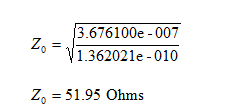A Comparison of the IPC Calculator, Wadell Formula and 2D Field Solver
For the 2D Field Solver, we used the following code
* Example: 2D Field Solver for Stripline
.OPTION PROBE POST
VIMPULSE in1 gnd PULSE 4.82v 0v 5n 0.5n 0.5n 25n
W1 in1 gnd out1 gnd
+ FSmodel=cond3_sys N=1 l=0.5
.MATERIAL diel_1 DIELECTRIC ER=4.5
.MATERIAL diel_2 DIELECTRIC ER=4.5
.shape rect_1 RECTANGLE WIDTH=6mils, HEIGHT=1.37mils
.LAYERSTACK stack_1
+ LAYER=(PEC,1um),LAYER=(diel_1,9.315mils),
+ LAYER=(diel_2, 10.685mils),LAYER=(PEC,1um),
.FSOPTIONS opt1 PRINTDATA=YES
.MODEL cond3_sys W MODELTYPE=FieldSolver,
+ LAYERSTACK=stack_1, FSOPTIONS=opt1, RLGCFILE=ex_howard.txt
+ CONDUCTOR=(shape=rect_1,ORIGIN=(0,9.315mils)),
.TRAN 0.5n 100n
.PROBE v(out1) v(out1)
.END
* L(H/m), C(F/m), Ro(Ohm/m), Go(S/m), Rs(Ohm/(m*sqrt(Hz)), Gd(S/(m*Hz))
.MODEL cond3_sys W MODELTYPE=RLGC, N=1
+ Lo = 3.676100e-007
+ Co = 1.362021e-010
+ Ro = 0.000000e+000
+ Go = 0.000000e+000

The Wadell’s formula method gives 51.58.
However, if we use,
b = 8.64,
t = 0.64,
er = 3.8,
w = 3.38
We get Zo = 40 ohms using Wadell’s formula. The Hspice 2D field solver produces exactly 50 ohms. We should therefore be careful in blindly following the formula across the range. In this particular case, Wavell formula seems to break when w/b > 0.35, though they seem to be accurate for w/b <= 0.35
Previous - Transmission Characteristic Impedance